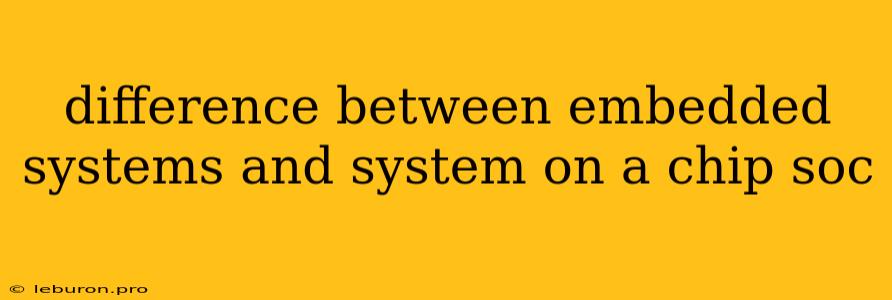The realm of electronics is vast and intricate, encompassing a myriad of devices and technologies. Among them, two prominent categories stand out: embedded systems and System-on-a-Chip (SoC). While both play crucial roles in the modern world, they differ significantly in their design, functionality, and applications. This article delves into the difference between embedded systems and System-on-a-Chip (SoC), shedding light on their unique characteristics and highlighting the factors that set them apart.
Understanding Embedded Systems
Embedded systems are specialized computer systems designed to perform specific tasks within larger systems. These systems are often embedded within devices or machines, controlling their operation and functionality. They are typically characterized by their limited resources, such as processing power, memory, and peripherals. Examples of embedded systems abound in everyday life, from smartphones and tablets to automotive systems and industrial robots.
Key Features of Embedded Systems
- Dedicated Functionality: Embedded systems are designed to perform specific tasks, often with a narrow range of operations.
- Real-time Processing: Many embedded systems require real-time processing, where tasks must be completed within specific time constraints.
- Resource Constraints: Embedded systems often operate with limited resources, including processing power, memory, and energy consumption.
- Hardware-Software Integration: The hardware and software components of embedded systems are tightly integrated, optimizing performance and efficiency.
- Reliability and Robustness: Embedded systems are designed to operate reliably in harsh environments and often require high levels of fault tolerance.
Delving into System-on-a-Chip (SoC)
A System-on-a-Chip (SoC) is an integrated circuit (IC) that combines multiple components, including a processor, memory, peripherals, and other functional blocks, onto a single semiconductor chip. This integration allows for a highly compact and efficient design, reducing the size, power consumption, and cost of electronic systems. SoCs are the heart of many modern devices, from smartphones and tablets to wearable devices and automotive electronics.
Key Characteristics of SoCs
- Integration of Components: SoCs integrate multiple components, such as a processor, memory, peripherals, and communication interfaces, onto a single chip.
- High Performance and Efficiency: The integration of components in SoCs enables high performance and efficiency, minimizing power consumption and size.
- Scalability and Flexibility: SoCs can be customized and scaled to meet the specific requirements of different applications, offering flexibility in design and implementation.
- Cost-Effectiveness: The integration of multiple components on a single chip reduces the cost of manufacturing and assembly, making SoCs cost-effective.
- Miniaturization: SoCs enable miniaturization of electronic devices, leading to smaller and more portable systems.
Differentiating Embedded Systems and SoCs
While embedded systems and SoCs share some similarities, they differ fundamentally in their architecture, design, and applications.
Key Differences:
- Scope and Complexity: Embedded systems are typically simpler in design and scope, focusing on specific tasks. SoCs, on the other hand, are highly complex integrated circuits that combine numerous functionalities.
- Level of Integration: Embedded systems often utilize discrete components and integrated circuits, while SoCs integrate all necessary components on a single chip.
- Design Focus: Embedded systems prioritize functionality, real-time processing, and resource optimization. SoCs prioritize performance, efficiency, and scalability.
- Applications: Embedded systems are used in a wide range of applications, from consumer electronics to industrial automation. SoCs are commonly used in high-performance computing, mobile devices, and automotive systems.
Similarities Between Embedded Systems and SoCs
Despite their differences, embedded systems and SoCs share several common features:
- Real-time Processing: Both embedded systems and SoCs can be designed for real-time processing, where tasks must be completed within specific time constraints.
- Hardware-Software Integration: Both systems rely on the close integration of hardware and software components for optimal performance and functionality.
- Resource Optimization: Both embedded systems and SoCs are designed to optimize resource utilization, minimizing power consumption and maximizing efficiency.
Conclusion
The difference between embedded systems and System-on-a-Chip (SoC) lies in their design, architecture, and intended applications. Embedded systems are specialized computer systems designed for specific tasks, while SoCs are highly integrated circuits that combine multiple functionalities. Understanding these differences is crucial for selecting the appropriate technology for a particular application.
As technology continues to advance, the lines between embedded systems and SoCs may become increasingly blurred. However, the fundamental concepts and key differences outlined in this article provide a clear framework for understanding these two important categories of electronic systems.
